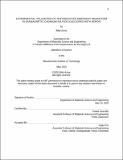Experimental validation of the predicted emergent magnetism in diamagnetic cadmium sulfide (Cds) doped with boron
Author(s)
Azhar, Bilal.
Download1262658570-MIT.pdf (1.210Mb)
Other Contributors
Massachusetts Institute of Technology. Department of Materials Science and Engineering.
Advisor
Jaramillo, Rafael
Terms of use
Metadata
Show full item recordAbstract
The large and persistent photoconductivity displayed by some semiconductors provides a way to control magnetism with light, through illumination-control of free carrier concentration and thereby magnetic interaction in dilute magnetic semiconductors. CdS is a wide band-gap semiconductor that displays large and persistent photoconductivity and is predicted to become magnetic when doped with certain dopants such as Boron[1]. In this work, we experimentally test the prediction of magnetic CdS:B, and lay groundwork for testing the hypothesis that magnetism can be controlled by photoconductivity. We make CdS:B nanoparticles by co-precipitation[2]. We use X-ray diffraction and plasma optical emission spectroscopy to quantify boron doping. We use magnetometry to confirm the presence of magnetic B.
Description
Thesis: S.B., Massachusetts Institute of Technology, Department of Materials Science and Engineering, May, 2020 Cataloged from the official PDF version of thesis. Includes bibliographical references (pages 41-42).
Date issued
2020Department
Massachusetts Institute of Technology. Department of Materials Science and EngineeringPublisher
Massachusetts Institute of Technology
Keywords
Materials Science and Engineering.